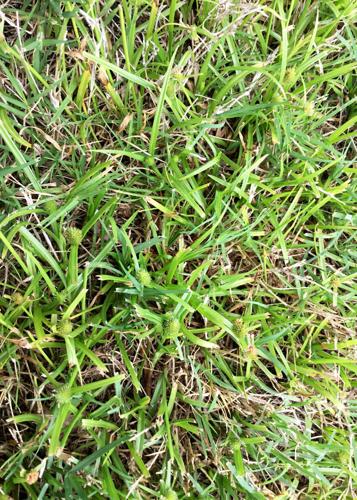Dear Neil: What is this weed that has invaded part of my yard? What can I do to eliminate it? It is very aggressive.
This is one of the types of nutsedge. They tend to thrive in wetter parts of our lawns where they can establish and outgrow the turfgrass. Sedges can always be identified by their triangular stems. Grass stems are round when rolled between the index finger and thumb. The flower heads such as are visible in your photo are another solid form of identification. They are quite different from grass seedheads.
There is a small group of herbicides specifically developed for control of nutsedge. Most common in the marketplace would be the original Image product as well as one called Sedgehammer. (Note the play on words with the misspelling of the name ĐÔĘӽ紫ýśSedgehammer.ĐÔĘӽ紫ýť) Read and follow label directions carefully for best results as they relate to timing and rates and methods of application.
Dear Neil: I was surprised to see you list wild onions as ĐÔĘӽ紫ýśdeadly poisonousĐÔĘӽ紫ýť in a recent story here. Surely those were not the small bunches (3-4 inches) of wild onions we harvested along the gravel roads in northeast Oklahoma each spring. We ate them in scrambled eggs, a native tradition.
I guess they werenĐÔĘӽ紫ý™t. YouĐÔĘӽ紫ý™re alive to ask about it. The plant that is commonly mistaken for wild onions is death camas (Toxicoscordion venenosum), and itĐÔĘӽ紫ý™s one you donĐÔĘӽ紫ý™t want to include in your cooking. I guess you could tell that by either its common or scientific names.
I want to back up a step and explain two things. First, the liability I assume in telling people they can eat various plants, including wild onions, mushrooms, and the like, is immense. These are things that cannot be identified by words alone, and usually not even simply by photographs. You need to have a veteran local botanist alongside to give sure clearance before you harvest things out of nature.
Second, my dad was a PhD plant taxonomist (botanist), and as such, he was Texas A&MĐÔĘӽ紫ý™s go-to expert in plants that were toxic to livestock and humans. This story goes back many decades, but in my childhood, I can remember his taking weekend calls from doctors and hospitals where people had been admitted after ingesting wild plants including wild onions (probably death camas). My warnings are based on the anguish I heard in his voice. Some things you never forget.
Dear Neil: I am battling Asian bark scale on a crape myrtle and have been using horticultural oil spray that is labeled for scale insects. After six consecutive daily sprayings IĐÔĘӽ紫ý™m not seeing visible improvements. Can you recommend something else?
IĐÔĘӽ紫ý™ve been working with this invasive pest, now known as crape myrtle bark scale, since 2004 ĐÔĘӽ紫ý“ in fact, the week it was first observed in the U.S., in Richardson, Texas. It was several years after that that confirmation came that it had been brought into the country from China.
Horticulturists with the Crape Myrtle Trails of McKinney worked with Texas A&M and Texas AgriLife Extension entomologists to determine that a soil drench of Imidacloprid made around the drip line of the plants in mid-May gave the best control – actually prevention of the next generation. You can see much more detail by going to the website , then clicking through to “Basic Care, Pests.” I wrote most of that website, so please just consider it to be an extension of this reply.
For what itĐÔĘӽ紫ý™s worth when you use horticultural oils for other pests, you normally would not want to keep applying it repeatedly as you described. Usually just one application should be sufficient if it is going to work. It was found that oils were not effective on crape myrtle bark scale.
Dear Neil: This suddenly appeared in our lawn this spring. What is it? What would be good to control it?
This is a robust outbreak of oxalis, also called sheep sorrel. It is a bit difficult to eliminate because of its very waxy leaves. The broadleafed weedkiller 2,4-D will kill it, but it will be much more effective if you mix in one drop of liquid dishwashing detergent per gallon of spray. Use a tank sprayer, not a hose-end type, and carefully coat the leaves with the mix using a fairly fine droplet size. Apply it just to the point of runoff. Note, too, that you have a start of nutsedge showing in this photo. ItĐÔĘӽ紫ý™s even more tenacious than the oxalis. As I mentioned to the prior reader, youĐÔĘӽ紫ý™ll want to use the original form of Image or Sedgehammer to bring its population down. Both are more effective as it gets even warmer. You may have to treat more than one time. But get rid of the oxalis first.
Dear Neil: We have Virginia creeper growing up a large live oak tree. The vineĐÔĘӽ紫ý™s trunk is at least 1 inch in diameter, but we donĐÔĘӽ紫ý™t let it climb into the canopy. Does it do any harm when left that way?
No. All it gains from the tree is support. Of course, its roots compete for water and nutrients, but the tree has a far more extensive root system.























